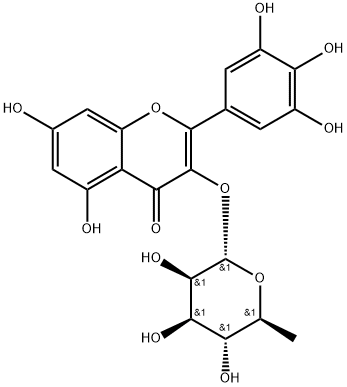17912-87-7

Product Name:
Myricitrin
Formula:
C21H20O12
Synonyms:
3,3′,4′,5,5′,7-Hexahydroxyflavone 3-O-rhamnoside;Myricetin 3-O-α-L -rhamnopyranoside;Myricetin 3-O-rhamnoside;Myricitroside
Inquiry
CHEMICAL AND PHYSICAL PROPERTIES
| Physical Description | Light yellow powder or mass, Slight bayberry aroma |
|---|---|
| Solubility | Practically insoluble to insoluble |
COMPUTED DESCRIPTORS
| Molecular Weight | 464.4 g/mol |
|---|---|
| XLogP3 | 0.5 |
| Hydrogen Bond Donor Count | 8 |
| Hydrogen Bond Acceptor Count | 12 |
| Rotatable Bond Count | 3 |
| Exact Mass | 464.09547607 g/mol |
| Monoisotopic Mass | 464.09547607 g/mol |
| Topological Polar Surface Area | 207 Ų |
| Heavy Atom Count | 33 |
| Formal Charge | 0 |
| Complexity | 760 |
| Isotope Atom Count | 0 |
| Defined Atom Stereocenter Count | 5 |
| Undefined Atom Stereocenter Count | 0 |
| Defined Bond Stereocenter Count | 0 |
| Undefined Bond Stereocenter Count | 0 |
| Covalently-Bonded Unit Count | 1 |
| Compound Is Canonicalized | Yes |
PRODUCT INTRODUCTION
description
Myricitrin is a glycosyloxyflavone that consists of myricetin attached to a alpha-L-rhamnopyranosyl residue at position 3 via a glycosidic linkage. Isolated from Myrica cerifera, it exhibits anti-allergic activity. It has a role as an anti-allergic agent, an EC 1.14.13.39 (nitric oxide synthase) inhibitor, an EC 2.7.11.13 (protein kinase C) inhibitor and a plant metabolite. It is a pentahydroxyflavone, a glycosyloxyflavone, an alpha-L-rhamnoside and a monosaccharide derivative. It is functionally related to a myricetin. It is a conjugate acid of a myricitrin(1-).
